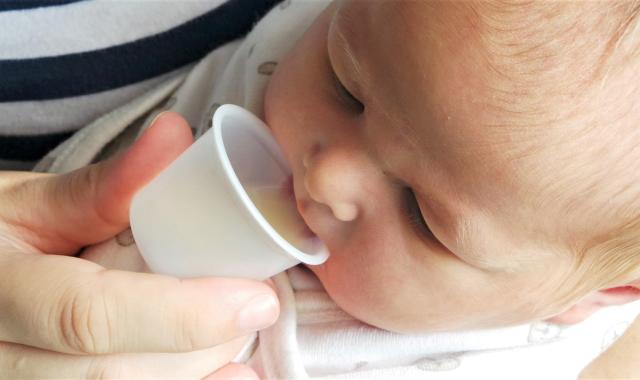Yes, babies can drink from a cup!

There are quite a few reasons why you might feed your baby from a cup.
-
You are giving your baby small amounts of breastmilk or colostrum.
-
You and your baby are separated for a period of time.
-
You need to give your nipples time to heal.
-
Your baby is refusing to breastfeed.
-
Your baby has a minor cleft of lip and/or palate.
-
To provide top-ups of expressed breastmilk or formula if needed.
-
You normally feed your baby by bottle but are in a situation where you can't safely clean feeding equipment (eg you have no power or no clean water). A cup is more easily cleaned than a bottle and teat.
What sort of cup do I use?
Small open cups are safest and can be cleaned easily. 'Sipper' lids and straws are suitable if your baby is older but without access to hot water, they aren't easy to clean well.
Get the equipment ready
-
a small soft-spouted cup or medicine glass and your expressed breastmilk (EBM)
-
a bib to catch any dribbles of milk - it can be messy when you and baby are learning
-
a well-supported chair and table.
-
Half-fill the cup and place the cup and any extra milk (for adding to the cup) on the table.
Get your baby ready
-
Make sure your baby is fully awake, calm and alert
-
Put the bib on your baby and sit on the chair, with baby on your lap.
-
Hold your baby in an upright position, with one of your hands supporting their shoulders and neck or support your baby in the crook of your arm.
-
You may need to keep their hands down and away from the cup by holding or lightly wrapping them.
-
Be careful not to lay your baby back because this can cause them to choke, splutter or breathe in some milk.
Bring the cup to baby's mouth
-
Hold the cup so that it just touches your baby's mouth and reaches the corners of their mouth, resting lightly on the bottom lip.
-
Tip the cup just enough so they can lap up the milk, bringing the tongue forward to do so. Do NOT pour the milk into baby's mouth.
-
Keep the cup in this tilted position.
Follow your baby's cues
Let them set the pace. Do not take the cup away when your baby pauses, unless they pull away.
At first cup-feeding may seem slow and messy. However in a short time the process becomes easier.
Getting help
When you start out, it’s a good idea to ask a child health nurse or lactation consultant to watch you to help ensure you learn how to cup-feed safely. It may feel awkward at first, but with practice cup-feeding gets easier.
Older babies and toddlers
Older babies or toddlers may accept expressed breastmilk from a cup. Many different sizes and types of cups are available - sippy cups, no-spill cups and cups with a straw (or with a built-in straw). You can experiment to see what works best for you and your baby/toddler.
© Australian Breastfeeding Association April 2022


